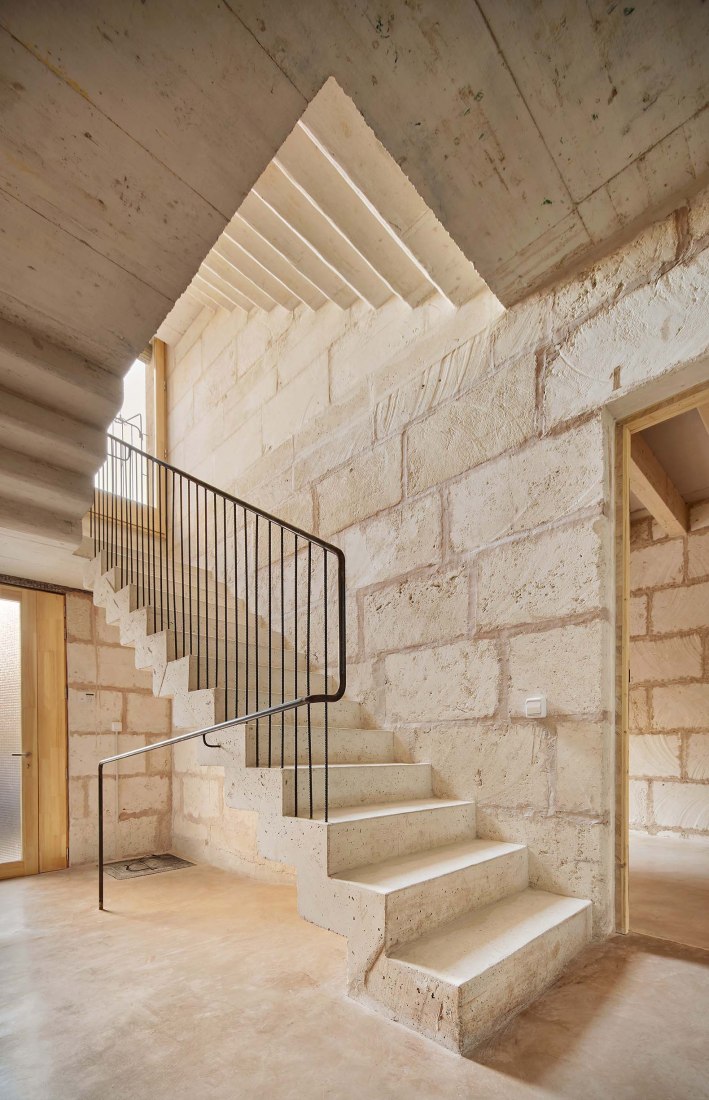The distribution of the five houses uses all the possible buildability by building the duplex typology on the right side of the staircase looking from the street, where the two houses are fitted on three floors like a puzzle. The other three houses are located on the left side of the staircase, one per floor.
Description of project by IBAVI
This is the first project completed by the Balearic Housing Institute (IBAVI) that continues the Reusing Posidonia research in Formentera, in this case adapted to the Mallorca resource map.
The building is located in Son Gotleu, a neighbourhood which began to be developed in 1943. Initially, the fine-grained urban fabric combined Mediterranean closed blocks with single-family homes. During the 1960s, in order to house the workers from mainland Spain who built the hotels in Palma beach, these single-family homes were replaced by the cheapest modern movement apartment blocks, without elevators, and which have become a focus of social conflicts. In fact, nowadays, Son Gotleu is one of the Palma neighbourhoods with the highest social vulnerability index and highest concentration of population with few economic resources. This conflict is another mass tourism side effect and its reversal requires all possible public and private efforts.
The project recovers and makes visible one of the best features of the neighbourhood: the town houses built with local sandstone, which reveal the resource map of the place, economically viable again in the 21st century thanks to the thermal and acoustic regulations for buildings. The climate emergency makes possible to recover those systems that would have avoided such a climate crisis.
The Marés sandstone it is the industrialized material with the smallest ecological footprint in Mallorca, and it has been used to build all the walls of the 3-storey building, except for the elevator shaft, which is made of reinforced white concrete, in order to comply with the earthquake resistant regulations. The objective is to demonstrate that the construction of load-bearing walls with this material, abandoned in the structural use of multi-family buildings for the last 30 years, allows compliance with current regulations and the Sustainable Development Goals (SDGs). The construction system is the same that was used by Jørn Utzon at Can Lis in 1972, consisting of 20 cm internal load-bearing walls and a 10 cm outer rain wall. To achieve compliance with comfort requirements, a 10 cm recycled cotton insulation has been incorporated into the air chamber, protected with a breathable waterproof sheet. Ceilings, low-emissive glass windows, roller shutters and doors are made of FSC certified wood.
The CO2 embodied emissions in the facade construction system are 31.62kg / CO2 per m2. If the façade had been resolved using a conventional solution, emissions would be around 126.04kg/ CO2, so the contamination produced during the construction of the façade has been reduced by 75%. This approach has been extended to all elements of the building.
At the comfort level, a long-term forecast of the average temperatures has been made. Considering a useful life of the building of 50 years in a scenario of global temperature increase of 2ºC (in case of achieving the long term goals contained in the Paris Agreement) it has been prioritized passive measures to resist heat in the summer season, introducing inertia (weight) as a basic element of temperature regulation. The inertia is solved by using local stone, with a density of 2,160kg / m3.
There are five dwellings, the maximum number allowed by urban regulations. Two of them are duplex at one side of the staircase, and three are simplex houses, one per floor at the other side of the staircase. Cross ventilation providing passive cooling is ensured in all homes.
The Building Energy Rating is A, and the hot water production is carried out by aerothermal pumps located on the deck, supported by photovoltaic sun panels.























































